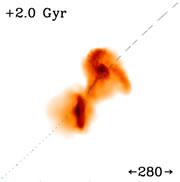 Click for a close-up view of how the two galaxies are expected to eventually merge.Harvard-Smithsonian Center for Astrophysics
Click for a close-up view of how the two galaxies are expected to eventually merge.Harvard-Smithsonian Center for AstrophysicsOur Milky Way galaxy is headed for a sedate collision with its neighbour, the Andromeda galaxy, billions of years earlier than was previously thought. The earlier date means that the Sun will still be alive when the two collide; and a new computer simulation shows what could happen to our star.
There's a good chance that it will be flung towards the outer edge of our galaxy, researchers say, and a tiny chance that it will be 'kidnapped' by Andromeda.
"The merger will take place before the Sun burns out, so that future astronomers within the Solar System can witness it," says Abraham Loeb of the Harvard-Smithsonian Center for Astrophysics in Cambridge, Massachusetts. Although this will be tens of millions of lifetimes from now, it is conceivable that humans may still exist when the two galaxies finally meet.
Using a sophisticated program for cosmological simulations known as GADGET-2, Loeb and colleague Thomas Cox modelled the future encounter to an unprecedented degree. Loeb says he and Cox factored in new data about Andromeda's motion in space as well as the expected contributions of dark matter to galactic movement. "We are the first to do a comprehensive numerical simulation that examines the detailed dynamics of the Milky Way and Andromeda, including the gas, dark matter and stars," says Loeb.
Some astronomers, however, think it may be a little premature to start predicting the fate of these galaxies, and particularly the Sun. John Dubinksi, an astrophysicist at the University of Toronto in Canada has explored this scenario before using models and animations. "I never thought there was enough detailed information about the nature of the structure and dynamics of the Milky Way-Andromeda pair to write a full-blown scientific paper about the future of the Sun," he says. "But I guess these guys have decided to take the plunge."
Collision course
It has long been known that Andromeda and the Milky Way will eventually merge, although it won't happen for a long while yet. They are approaching each other at 120 kilometres per second, but there is a great gulf of more than 2 million light years between them.
In 1959, it was determined using Kepler's laws of motion that both galaxies had traced out almost a full period of their orbital motion and were falling back together, with the next close passage occurring about 4 billion years from now.
But that calculation was made in the days before it was realized that all galaxies are immersed in extended, massive dark-matter haloes. The added mass of the haloes makes the Milky Way and Andromeda galaxies more gravitationally attractive and this speeds up the merger process. Cox and Loeb conclude that the next close passage will occur in less than 2 billion years.
Over a period of half a million years, the two galaxies will pass through each other, with individual stars passing through the gaps (the chances that two stars might collide are very slim). Many of the stars will be gravitationally perturbed by the collision — some may even be ripped from one Galaxy and take up residence in the other.
After this passage, the two galaxies will swing by each other again more quickly, about 3.5 billion years from now, and will finally merge into a single blob some 5 billion years from now, Cox and Loeb say. This 'merger remnant' will be a huge, slowly rotating sphere containing several hundred billion stars. Astronomers refer to these galactic specimens as low-to-medium-luminosity elliptical galaxies. Cox and Loeb give this one the name Milkomeda.
Eviction
After the pass at 2 billion years, the Sun is most likely to remain in the (now disturbed) disk of the Milky Way, at its present distance of 26,000 light-years from the galaxy's centre. But there is a 12% chance that it will be ejected from the Milky Way into a trailing tail of material, some 65,000 light years from the former centre, say Cox and Loeb. Their team is now trying to produce a picture of what the night sky will look like from Earth.
ADVERTISEMENT
The odds that the Sun will be ejected to at least this distance goes up for the second pass at 3.5 billion years: there's a 30% chance of ejection at the beginning of this collision, and 48% after it. By the time the merger remnant has formed, there is a 68% chance that the Sun will have been pushed out.
There is a small possibility — only 2.7% — that the Sun will be gravitationally captured by the Andromeda galaxy before Milkomeda coalesces. In their paper, the authors write that, though this outcome was unexpected and exciting to consider, it is relatively unlikely.
Visit our thesunbestolenbyanot.html">newsblog to read and post comments about this story.
-
References
- Cox T. J. & Loeb A., http://arxiv.org/pdf/0705.1170 (2007).
